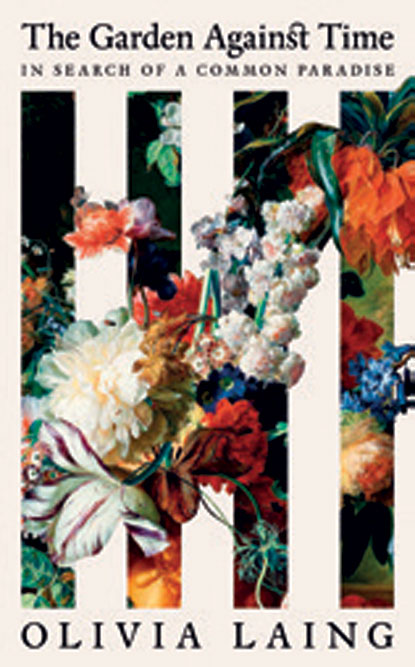OLIVIA LAING’S BOOKS serve as both a hug and an alarm. The British author and cultural critic has the singular ability to pick apart human experience and then to assemble it in a way where the messiness makes sense. The author of seven books, she is well known for her memoir/biography The Lonely City: Adventures in the Art of Being Alone (2016). The ‘loneliness epidemic’ is now an all too familiar trend, but Laing’s book was the first serious work that took a vague yet stigmatised term like ‘loneliness’ and gave it heft and meaning. She had moved to New York in her mid-thirties and was awash with loneliness. Fascinated and perturbed by this experience, she investigated loneliness and the city through the works and lives of artists. She reminded us all that “loneliness is a longing not just for acceptance but also for integration”. She followed up The Lonely City with a novel Crudo (2018), a collection of essays Funny Weather: Art in an Emergency (2020) and Everybody: A Book About Freedom (2021). The 47-year-old has rightly been hailed as a “cultural sage,” not just for her wisdom, but also the intimacy of her writing. She combines the personal with the political, whether she is writing about Edward Hopper or Nina Simone or herself. I don’t know about ‘the most important’ but it would not be a stretch to say that Laing is the most compassionate living cultural critic. Her books reassure (there is discovery and pleasure to be had in this world) but also warn us against the growing grip of capitalism and technology.
Her latest book The Garden Against Time: In Search of a Common Paradise (Picador; 336 pages; ₹1199) is once again a perfect example of her ability to approach any subject as both an epidemiologist and an aerial photographer. She zooms in super close to reveal unseen details and then she can draw back out to provide context and the big picture. Like The Lonely City, The Garden Against Time is seeded in personal experience, but then shoots much farther. In 2020, Laing trained as a medical herbalist, moved into a house with a garden in Suffolk, it was the first time, in a long time, that she would no longer be a renter. She discovered that the garden had originally been laid out by a “distinguished gardener” Mark Rumary. Over the next four years, and through the pandemic, the garden became both her abbey and her gym; a place of meditation and exertion. While Laing had grown up with a father who loved gardening and had always been invested in the natural environment, she was not the only one to seek out the home garden in those years. She writes, “Over the course of 2020, three million people in Britain began to garden for the first time, over half of them under forty-five…The same pattern was repeated globally, from Italy to India.” Millennials turned to gardening with zeal, seed companies from the US to Russia reported record sales. “It was as if, during that becalmed and frightening season, plants had emerged into collective visibility, a source of succour and support,” she writes.
With her botanist’s understanding, her training as a journalist, and her philosophical bent, Laing shows that a garden can be an Eden, but that it can also conceal histories of colonialism and slavery, and the exploitation of resources. Whether she is writing about gardens or human bodies, Laing establishes that both can be a burden and a source of power. She reveals “the hidden cost, the submerged relationship with power and exclusion” that many gardens carry. An Indian reader might feel alienated by the many names of unfamiliar plants and flowers, but The Garden Against Time is more than a book in praise of tending to the earth. It is about the glue of families, the meaning of home, the beauty of the natural world and how the grass and bees and flowers are also reality. She writes of the perils of capitalism and how “one of the operations by which capitalism perpetuates itself is displacement, the determined and absolute separation of the product from the site of production.” We buy, buy, buy products ignoring their origin story and the after-effects which are often destructive.
As a perpetual outsider who grew up with divorced parents and then an alcoholic elder in the family, Laing’s autobiography drizzles The Garden Against Time but never overwhelms it. She has lived in all-women housing co-ops, she has lived alone in an abandoned pig farm, where she slept with an axe below her pillow. Her home in Suffolk, with poet and academic Ian Patterson, allowed her a sense of permanence that she had been denied before.
The Garden Against Time is about paradise. It’s an attempt to look sceptically at the idea of paradise, to consider who is excluded or exploited to create it, but it’s also an investigation into the many rebel or renegade visions of a more inclusive paradise that have been attempted over the centuries, says Olivia Laing, author
Share this on 

Laing’s writing is lush but never florid. There is a precision and acuity to her sentences, which made me highlight passage after passage, page after page. And some of her sentences are creatures of pure beauty. She writes, “Time stopped in a garden…where the hours are not timetabled but drip like honey from the spoon.”
We were to speak over Zoom, but then sickness and schedules got in the way and after much back and forth, we had to make do with email. Excerpts:
Starting with a speculative question, if you’d found your garden in Suffolk back in 2010, do you think you’d have written The Lonely City?
That is a very interesting question! I suppose if I’d found it alone I might have written a more rural version, but part of what drove The Lonely City was the feeling of having failed, not just in the sense of not having a relationship, but also not owning a house or having a job or being tethered and secure in any of those traditional ways. It’s a book about insecurity, impermanence, lack of roots of all kinds and so I think it could only have been written by someone single and renting—in fact mostly subletting, in a major city. I think that’s why it speaks to young people from Generation Rent so strongly, even now.
In what ways is The Garden Against Time the conclusion of a trilogy, with The Lonely City and Everybody?
The Lonely City is about a kind of twenty-first century purgatory, an experience of alienation and separation that is epitomised by being trapped behind a window or a screen, or alone in the midst of a crowd. Everybody is really a descent into hell, especially the hell of being inside a body that is subject to violence. It was a hard book to write and it really tries to engage with the fascism that is everywhere in our time, and to collect up the many ways that people have fought for bodily freedom, which is to say the freedom to exist no matter what type of body they inhabit. And then The Garden Against Time is about paradise. It’s an attempt to look sceptically at the idea of paradise, to consider who is excluded or exploited to create it, but it’s also an investigation into the many rebel or renegade visions of a more inclusive paradise that have been attempted over the centuries.
People exist inside their own echo chamber, and I wanted to get away from that, to communicate with readers who perhaps don’t share my socialist politics. With The Garden Against Time, I wanted the book itself to feel like a garden you could rest in, full of beauty and pleasure. The reader is introduced to difficult ideas about colonial violence, slavery, climate change, war, and the sections about my own garden should serve as a space to think, says Olivia Laing
Share this on 

You are initially very aware that you are in a garden of some historic importance. What is it to make a garden, from someone else’s garden?
For the first two years I worked very hard to restore Mark [Rumary]’s garden. I’m sure that was driven by the pandemic, and the powerful desire to repair something during a time of pervasive fear and suffering. After that, it gradually became my garden. It’s wilder and more naturalistic now. But I’ve tried to respect Mark’s sensibility. He’s still very present in the garden.
The Garden Against Time makes clear that gardens have a hidden relationship with colonialism and slavery. While writing the book what were the challenges of trying to balance the beauty of gardens, with their dark histories?
Politics has become increasingly polarised over the past few years, driven by social media and its appalling algorithms. People exist inside their own echo chamber or bubble, and I wanted to get away from that, to communicate with readers who perhaps don’t share my own radical, socialist politics. When I wrote Everybody I really removed all lyricism from my writing. I wanted it to be austere, astringent, absolutely clear and unadorned. With The Garden Against Time, I let the lyricism back in. I wanted the book itself to feel like a garden you could rest in, full of beauty and sensual pleasure. The reader is introduced to difficult and perhaps challenging or unfamiliar ideas about colonial violence, slavery, climate change, war, and the sections about my own garden should serve as a space to think, to reflect and to digest. I want the reader to be changed by what they discover, but I also want them to feel nourished and inspired to create a better world, not exhausted and filled with despair.
You write, “Sense of home is reciprocal; one doesn’t just know, but is known.” Do you feel that after decades of wandering, you’ve found home?
I don’t think this is my final garden. I would like to make another, perhaps from scratch, and probably not on sand! Love makes a place a home. Time and energy make a place home. A deep investment. Knowing every plant here makes me feel grounded and rooted. It’s like the poet John Clare says: you don’t just know; you are known.
While describing Villa Livia in Rome you say it was a “garden against time”… did the title come to you while you were visiting it?
For a long time, the book was called Here, like Everybody was called The Body Book. I often have working titles that aren’t quite right. To the River was called Going Under. I can remember exactly the moment I thought of Everybody—I was walking across Parkers Piece in Cambridge. But The Garden Against Time emerged about halfway through the book. It had the right strangeness. It’s slightly mysterious. The book is about the garden against the backdrop of time, through history, but it’s also about the garden as an antidote to capitalist time, which is hallmarked by an obsession with permanent growth, perpetual abundance, never-ending youth; a refusal to accept death, ageing and decay. That mind set has been very damaging to the planet and is one of the key drivers of climate change. I think of the garden now as a kind of anti-capitalist clock, which can induct us into a new model of time. New! A very ancient model of time.
The process of putting the world into language is deeply strange, and the challenge is to avoid pre-formed content, to really think it into being anew. I think all the time about what David Wojnarowicz meant when he said ‘the pre-formed world’ and I’ve come to think that this is the great enemy of the artist. We have to find the language to show the world as it is today, this minute, this second, as it has never been before and will never be again. I think that’s a very fertile thing to do, says Olivia Laing
Share this on 

You write, “I went to wherever caught my eye and worked over it just as an editor rakes over a text looking for what does not belong”. What are the similarities between writing and gardening?
I first noticed this when I was gardening early in the morning, and would go out with my secateurs and start pruning or clipping away at whatever wasn’t working. Then I’d go inside, open my Word doc and start doing the same thing. So there’s definitely a similarity between the editorial element of the two tasks. But there’s also a similarity on an architectural level. You’re building structures, you’re creating an overarching grand design, and that requires vision but also a lot of attention to the tiniest detail.
How has gardening changed your relationship with putting words down? Does writing seem too sterile now?
No, writing is still exciting and mysterious to me. The process of putting the world into language is deeply strange, and the challenge is to avoid pre-formed content, to really think it into being anew. I think all the time about what David Wojnarowicz meant when he said ‘the pre-formed world’ and I’ve come to think that this is the great enemy of the artist. We have to find the language to show the world as it is today, this minute, this second, as it has never been before and will never be again. I think that’s a very fertile thing to do.
AO Scott in the New York Times called you, “natural hybridizer.” “She belongs in an as-yet-undefined and perhaps undefinable class of prose artists who blend feeling and analysis, speculation and research, wit and instruction…” Finally, what plant do you see yourself as? Are you a hybrid plant?
Oh wow! Hmmm. Tormentil has seeded itself in the library garden, beside some Iris pallida. It’s crept over the irises and sent its tendrils out onto the terrace, spangled here and there with tiny yellow flowers. It travels with gentleness, but it certainly doesn’t respect formal boundaries between domains. It gets everywhere. I think that might be my emblem as a writer.

/wp-content/uploads/2024/08/Gardenqueen1.jpg)

/wp-content/uploads/2025/01/Cover_Kumbh.jpg)














More Columns
What does the launch of a new political party with radical background mean for Punjab? Rahul Pandita
5 Proven Tips To Manage Pre-Diabetes Naturally Dr. Kriti Soni
Keeping Bangladesh at Bay Siddharth Singh